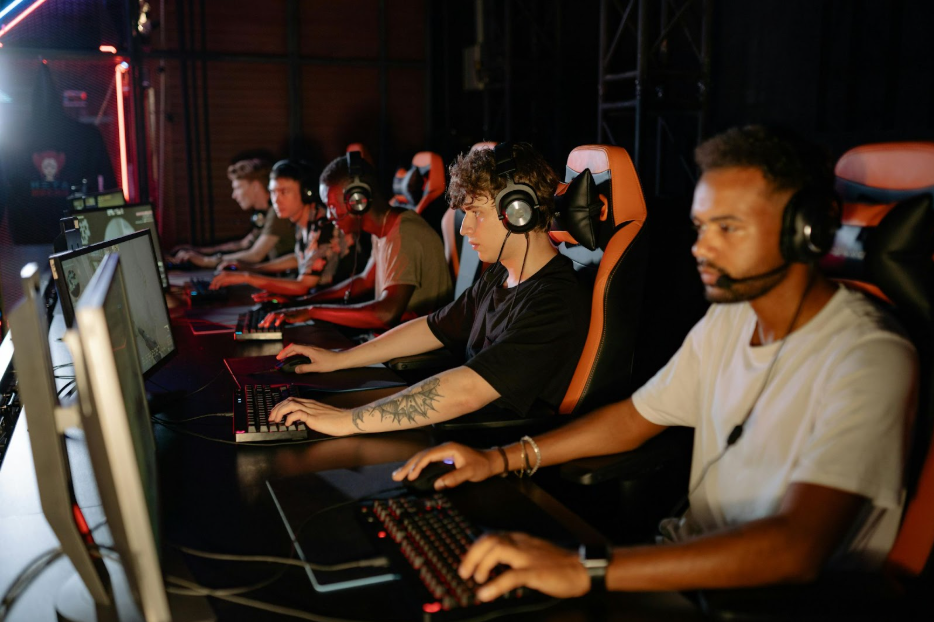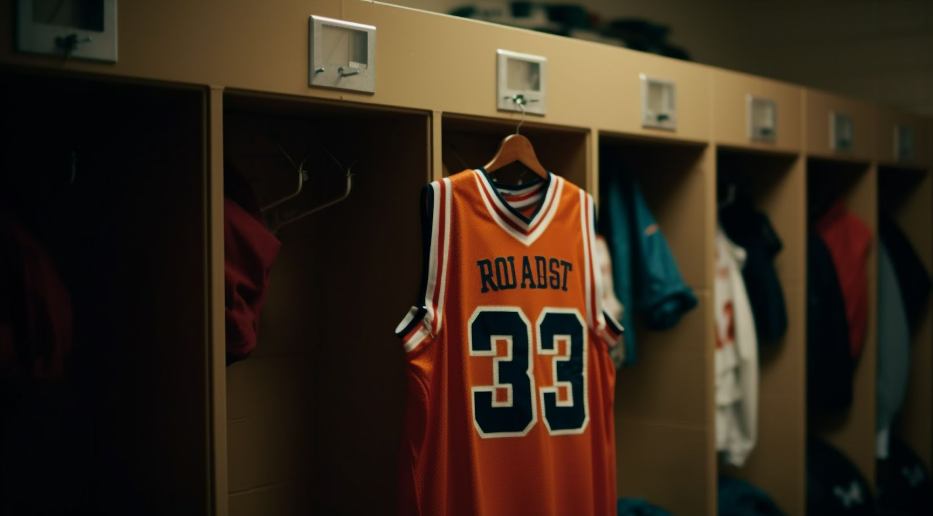Whether you are part of a professional team or a casual gaming group, a well-designed jersey can enhance team spirit and provide a sense of identity. By following this comprehensive guide, you will be well-equipped to create a well-crafted, custom jersey that meets your needs and showcases your esports team’s unique style.
Key Takeaways
- Material Matters: Choose fabrics like polyester or nylon for performance-focused features, while cotton offers comfort for casual gaming. Spandex blends add flexibility.
- Fit Is Key: Opt for a slim, regular, or relaxed fit depending on comfort and movement needs.
- Customization Counts: Ensure accurate sizing by consulting charts and creating mock-ups to perfect logo placement and design layout.
What Materials Are Best For Esports Jerseys?
Selecting the best material for your custom esports jersey is crucial for both comfort and performance. Here’s a breakdown of the most popular materials used for esports jerseys and what makes each one stand out.
Polyester
Polyester is one of the most widely used materials in the production of esports jerseys. Known for its durability and lightweight nature, polyester is an excellent choice for high-performance athletic wear.
The fabric is highly resistant to shrinking and stretching. It’s also quick-drying and has excellent moisture-wicking properties, which help to keep the wearer cool and dry during intense gaming sessions.
Spandex (Elastane)
Spandex, also known as elastane, is often blended with other fabrics to provide stretch and flexibility. This material is highly elastic, allowing for a snug fit that can accommodate a wide range of body movements without causing discomfort. This is particularly beneficial for gamers who require unrestricted movement during gameplay.
Nylon
Nylon is another popular material used in the creation of esports jerseys. Known for its strength and resistance to abrasion, nylon is also lightweight and has good moisture-wicking properties. Additionally, nylon is resistant to mildew and mold, ensuring that the jersey remains fresh even after prolonged use.
Cotton
While not as commonly used as synthetic materials, cotton provides a high level of comfort for the wearer. However, it is important to note that cotton does not have the same moisture-wicking capabilities as polyester or nylon, which can make it less suitable for high-intensity gaming sessions.
Performance and Comfort Factors
When designing a custom esports jersey, selecting the right fabric is crucial for balancing performance and comfort.
Breathability is essential for keeping players cool during long sessions. Similarly, moisture-wicking properties play a key role in keeping the jersey dry. Polyester and nylon are highly efficient at moving sweat away from the body, whereas cotton retains moisture, which can become uncomfortable during extended periods.
Beyond performance, durability, and comfort are considerations that can vary across fabrics. Polyester and nylon are durable and can maintain their quality over time, especially when cared for properly. Cotton offers a softer, more natural feel but may lose its shape and vibrancy after repeated washings. Spandex, when blended, adds flexibility and stretch.
To help you compare these fabrics at a glance, here’s a summary table breaking down their key attributes:
| Material | Breathability | Moisture-Wicking | Durability | Comfort |
| Polyester | High | Excellent | High | Lightweight |
| Cotton | High | Low | Moderate | Soft |
| Nylon | Moderate | Good | High | Snug Fit |
| Spandex | Moderate | Good | Moderate | Flexible |
Choosing the Right Material for Your Custom Esports Jersey
When deciding on the material for your custom esports jersey, consider the following factors:
Type of Gameplay
If you are involved in competitive gaming, you may prioritize performance features like moisture-wicking and durability. For casual gaming or team events, comfort may be more important.
Climate and Environment
The climate in which you will be wearing the jersey can also influence your material choice. In warmer environments, breathable and moisture-wicking materials like polyester are ideal. In cooler climates, a cotton blend may provide additional warmth and comfort.
Personal Preferences
Some gamers prefer the lightweight feel of polyester, while others may favor the softness of cotton. Consider trying on jerseys made from different materials to determine which one feels best for you.
Customization Options
When you design your own esports jersey, the material can affect the customization options available. Polyester and nylon are well-suited for sublimation printing, which allows for vibrant and long-lasting designs. Cotton may be better for screen printing or embroidery, depending on the complexity of your design.
Are There Eco-Friendly Material Options Available?
In recent years, the demand for eco-friendly materials in the production of custom esports jerseys has increased significantly. This shift is driven by a growing awareness of environmental issues and a desire to reduce the carbon footprint associated with apparel manufacturing.
Several eco-friendly materials are available for custom esports jerseys, each with unique properties and benefits. The most common options include:
- Recycled Polyester (rPET): Made from recycled plastic bottles, rPET is a popular choice for eco-friendly sportswear. It offers similar performance characteristics to virgin polyester, such as moisture-wicking and durability, but with a significantly lower environmental impact.
- Organic Cotton: Grown without the use of synthetic pesticides and fertilizers, organic cotton is a sustainable alternative to conventional cotton. It is biodegradable, soft, and breathable, making it suitable for casual esports jerseys.
- Bamboo Fabric: Bamboo is a fast-growing, renewable resource that requires minimal water and no pesticides. Bamboo fabric is naturally antibacterial, moisture-wicking, and highly breathable.
- Tencel (Lyocell): Tencel is made from sustainably sourced wood pulp, typically from eucalyptus trees. The production process is environmentally friendly, using a closed-loop system that recycles water and solvents. Tencel is soft, breathable, and has excellent moisture-wicking properties.
How Do I Choose The Right Size For My Custom Jersey?
When designing a custom esports jersey, selecting the correct size is crucial to ensure comfort and optimal performance. To achieve this, you should refer to specific sizing charts provided by the manufacturer or supplier. These charts typically offer detailed measurements for various parts of the body, allowing you to choose the size that best fits your physique.
If you are ordering from an international manufacturer, you may need to convert your measurements to different sizing standards.
After recording all your measurements and comparing them to the sizing chart, double-check your measurements and ensure you have selected the correct size. If you have any doubts, consult with the manufacturer for guidance.
| Pro Tip: When measuring for your custom jersey, avoid wearing bulky clothing as it adds extra inches. Hold the tape snug but not tight, and always keep it level for accurate horizontal measurements like chest, waist, and hips. |
Different Fits for Custom Esports Jerseys
Choosing the right fit is key for both comfort and performance. Common options include slim fit, regular fit, and relaxed fit, each offering specific advantages for different body types and preferences:
- Slim Fit: A close, body-hugging fit that enhances mobility and provides a sleek, modern look. Ideal for those with a lean or athletic build.
- Regular Fit: Versatile and comfortable, this fit balances form and function, making it great for various body types and team uniforms.
- Relaxed Fit: A looser, more casual fit prioritizing comfort and flexibility—perfect for those preferring a laid-back style.
Always check the sizing chart and take accurate measurements to ensure the best fit for your custom jersey.
Are There Any Restrictions on the Number or Size of Logos?
When designing a custom esports jersey, one of the critical considerations is the inclusion of team logos and sponsor graphics. The number of logos you can include on a custom esports jersey often depends on the manufacturer’s guidelines and the design template you choose.
While some manufacturers may allow unlimited logos, others may impose restrictions to maintain the jersey’s visual balance and readability. Here are some common considerations:
- Team Logo: Typically, the team logo is prominently displayed on the front of the jersey, often on the chest area. This is usually the most significant and central logo on the jersey.
- Sponsor Logos: Sponsor logos are generally placed on various parts of the jersey, including the sleeves, back, and lower front. The number of sponsor logos can vary, but it is common to see between 2 to 5 sponsor logos on a jersey.
- Player Name and Number: While not logos, the player’s name and number are also essential elements that need to be accommodated within the design.
| Pro Tip: Always create mock-ups of your esports jersey design before finalizing. This allows you to visualize the layout and catch any issues with placement or proportions, ensuring the final product looks exactly how you envisioned. |
Bringing Your Esports Jersey Vision to Life
Designing a custom esports jersey involves several key considerations, including material selection, sizing, logo placement, production timelines, and cost factors. By understanding these elements and addressing common questions, you can create a jersey that meets your team’s needs and enhances your overall performance and appearance.
















